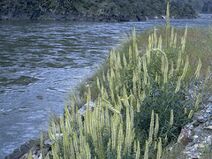Stanleya pinnata
| Stanleya pinnata | |
 | |
| Light: | |
| Moisture: | |
| Hardiness: | 7 |
| Soil pH: | 5.6-8.4 |
| Height: | 3' |
| Width: | 1' |
| Blooms: | Mid Summer-Early Fall |
| Native to: | |
| Edible Rating: | |
| Medicinal Rating: | |
| Tea: | Yes |
Stanleya pinnata (common name: prince's plume) is a desert perennial that is a good indicator plant of selenium rich soil when growing in the wild.[1]
Propagation: Seed - sow spring in a greenhouse. Germination should take place within 3 weeks. Pot up into individual pots as soon as the plants are big enough to handle in order to preserve the root system. Plant out in summer.
Division in spring?
Cultivation: Requires a perfectly drained soil in full sun.[1] Grows well in an ordinary garden soil[2]. Prefers a poor dry soil[3].
Hardy to about -20°c[3].
Grows well at Kew in a warm sunny well-drained border[K].
There is some confusion over the correct name of this plant, 2 different spellings having been used. Whilst it is possible that these are 2 different plants, it is more likely that the name used at the top of this form is the correct one, whilst the name in the synonyms list is a mis-spelling[4][K].
Range: South-western N. America - California.
Habitat: Seleniferous soils, desert slopes and washes to 1500 metres[5].
Edibility: Seed - cooked. It is used as a piñole[6][4]. The seed can be parched, ground into a powder and used as a mush[7].
Young leaves and stems - cooked[8][9][10][4]. A cabbage-like flavour, they can be quite bitter at first but changing the water once or more whilst cooking removes the bitterness[7][11]. Used in the spring[12]. Changing the water also removes many of the vitamins and minerals[K].
Medicinal: A decoction of the root has been used as a tonic to treat general debility after an illness[11]. The pulped root can be placed on the gum or in a tooth cavity in order to relieve toothache[13][11]. It can also be applied externally as a poultice to relieve earache and rheumatic pain[13][11]. A poultice of the mashed root has been applied to the throat to treat throat pain and is also used to treat the congestion of diphtheria[11].
A poultice of the plant has been applied to glandular swellings[11]. The powdered plant has been applied as a specific to scraped syphilitic sores[11].
A poultice of the freshly chewed seedpods has been used to treat itches[11].
Pollinators: Insects
Soil: Can grow in light and medium soils.
Drainage: Prefers well drained soil.
Flower Type: Hermaphrodite
Also Known As: S. pinnatifida. Nutt.
Links
References
- ↑ 1.0 1.1 Huxley, Anthony. The New Royal Horticultural Society Dictionary of Gardening. MacMillan Press, 1992.
- ↑ Chittendon, Fred. RHS Dictionary of Plants. Oxford University Press, 1951.
- ↑ 3.0 3.1 Phillips, Roger and Martyn Rix. Perennials - The Definitve Reference. Pan Books, 1991.
- ↑ 4.0 4.1 4.2 Yanovsky, Elias. Food Plants of the North American Indians Publication 237. US Department of Agriculture.
- ↑ Munz, David. A California Flora. University of California Press, 1959.
- ↑ Tanaka, Tyōzaburō. Tanaka's Cyclopaedia of Edible Plants of the World. Keigaku Publishing, 1976.
- ↑ 7.0 7.1 Facciola, Stephen. Cornucopia - A Source Book of Edible Plants. Kampong Publications, 1990.
- ↑ Uphof, Johannes. Dictionary of Economic Plants. Weinheim, 1959.
- ↑ Usher, George. A Dictionary of Plants Used by Man. Constable, 1974.
- ↑ Saunders, Charles. Edible and Useful Wild Plants of the United States and Canada. Dover Publications, 1976.
- ↑ 11.0 11.1 11.2 11.3 11.4 11.5 11.6 11.7 Moerman, Daniel. Native American Ethnobotany. Timber Press, 1998.
- ↑ Whiting, Alfred. Ethnobotany of the Hopi. North Arizona Society of Science and Art, 1939.
- ↑ 13.0 13.1 Coffey, Timothy. The History and Folklore of North American Wild Flowers. Facts on File, 1993.